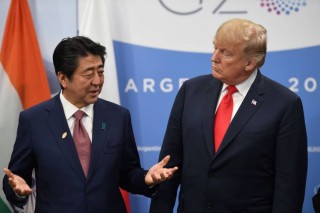Loading
Search
▼ Trump Puts Japan In Crosshairs After Trade Truce With China
- Category:Tourism
BUENOS AIRES – Now that U.S. President Donald Trump has agreed to a cease-fire with Chinese leader Xi Jinping over a trade war between their countries, Trump appears certain to shift his focus toward crafting a bilateral trade deal with Japan.
After signing a revamped trade pact Friday with Mexico and Canada with better terms for the United States, Trump agreed with Xi on Saturday to work to resolve issues such as forced technology transfer and intellectual property protection in exchange for suspending new U.S. tariffs on Chinese imports for 90 days.
The developments on the sidelines of the Group of 20 summit in Buenos Aires came as Washington readies for negotiations with Tokyo on a bilateral trade deal that could come as early as mid-January. Trump has repeatedly voiced his determination to slash Japan’s trade surplus with the United States.
Advocating “fair” and “reciprocal” trade, Trump has called for reducing the U.S. trade deficit with trading partners such as China, Mexico and Japan — the first to third-biggest generators of goods trade deficit with the United States last year.
Under Trump’s “America First” mantra, addressing trade imbalances with these countries is a top agenda item in his 2020 re-election bid, especially after his Republican Party lost a majority in the House of Representatives in the Nov. 6 midterm elections.
In a meeting Friday with Prime Minister Shinzo Abe in Argentina’s capital, Trump called the U.S. trade deficit with Japan “massive” and “pretty substantial.”
“We hope that we’re going to be balancing it very quickly,” he added.
While Japanese officials insist Tokyo and Washington aim for a bilateral trade agreement on goods only, U.S. officials have pushed for the inclusion of services and even a provision to prevent currency devaluations in an envisaged deal.
Analysts are watching how the Trump administration will balance its ambitions for a comprehensive pact, like a free trade agreement with the U.S. agricultural industry’s thirst for a deal, when other farming nations such as Australia and Canada are gaining greater access to the Japanese market through the Comprehensive and Progressive Agreement for Trans-Pacific Partnership, an 11-nation FTA that will enter into force on Dec. 30.
Similarly, Japan and the European Union are speeding up domestic procedures for the early enforcement of an FTA, making U.S. farmers and ranchers less competitive than their European counterparts in terms of access to the world’s third-largest economy.
“What the Japanese are hoping to do is to drag this out as long as they can, even potentially waiting out the end of the Trump administration,” said Benjamin Self, vice president of the Maureen and Mike Mansfield Foundation in Washington.
Self, an expert on U.S.-Japan relations, was referring to the upcoming trade negotiations, which will be led by U.S. Trade Representative Robert Lighthizer and Toshimitsu Motegi, Japan’s economic revitalization minister.
“They’ll agree to a smaller deal faster if what Trump wants is a faster deal,” he said, in reference to Japanese negotiators.
In the talks, the Trump administration is expected to demand increased market access to Japan’s automobile market, as well as to push Japanese automakers to expand their manufacturing in the United States, a measure that would reduce exports into the country and create more jobs there.
Trump regards automobiles as a symbol of the trade imbalance with Japan, apparently because automobiles and auto parts accounted for about 75 percent of the U.S. deficit with the country as of 2017.
Given that Japan imposes no tariffs on foreign cars, analysts expect the administration to focus on nontariff barriers and demand that Tokyo ease safety and environmental requirements for American vehicles, for example.
Aside from automobiles, tough negotiations are expected in agriculture, as well.
U.S. Agriculture Secretary Sonny Perdue’s calls on Japan to reduce tariffs on farm products beyond levels agreed to under the CPTPP runs counter to the understanding reached between Trump and Abe in September that Washington would not demand deeper farm tariff cuts than levels Tokyo has agreed in other trade pacts, such as the CPTPP and the Japan-EU FTA.
Perdue’s action, which may be seen as a hardball negotiation tactic ahead of the talks, may not serve the U.S. farm industry’s desire for a swift deal, either.
“Unfortunately, U.S. beef faces a massive 38.5 percent tariff in Japan — a trade barrier that hurts America’s beef producers,” said Kevin Kester, president of the National Cattlemen’s Beef Association, the marketing organization and trade association for 1 million cattle farmers and ranchers in the United States.
The organization “looks forward to working closely with the Trump administration to secure increased market access for our industry,” Kester said in September, when Trump and Abe agreed to launch bilateral trade agreement talks.
“The faster negotiations conclude, the faster U.S. producers can provide more Japanese consumers with the high-quality beef they demand,” Kester added.
Under the CPTPP — a pact from which Trump withdrew the United States last year — Japan’s 38.5 percent tariff on beef imports will be lowered in stages to 9 percent over 16 years.
- December 3, 2018
- Comment (0)
- Trackback(0)


